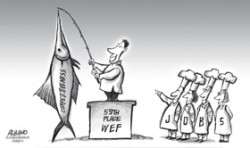- Home
- |
- About Us
- |
- Working Groups
- |
- News
- |
- Rankings
- WEF-Global Competitiveness Report
- Ease of Doing Business Report
- IMD-World Competitiveness Yearbook
- TI-Corruption Perceptions Index
- HF-Economic Freedom Index
- WEF-Global Information Technology Report
- WEF-Travel and Tourism Report
- WIPO-Global Innovation Index
- WB-Logistics Performance Index
- FFP-Fragile States Index
- WEF-Global Enabling Trade Report
- WEF-Global Gender Gap Report
- Gallery
- |
- Downloads
- |
- Contact Us
Competitiveness means more jobs

THE good news is that the Philippines has moved up six notches in the 2013 Global Competitiveness Report of the World Economic Forum (WEF), reaching the No. 59 spot. According to the report (which measures productivity and competitiveness by gathering data on 119 factors grouped into 12 pillars or categories, such as institutions or governance, infrastructure, macroeconomic environment, health and primary education), the Philippines posted an overall score of 4.3, up from last year’s 4.2.
The ranking the Philippines got this year—surpassing India, which took the 60th spot—puts the country among “the most dynamic and rapidly improving economies in terms of competitiveness,” the WEF said.
“The trends are positive across most dimensions…. The current [administration], which came into power in 2010, has made the fight against corruption an absolute priority; corruption had historically been one of the country’s biggest drags on competitiveness,” it added.
Understandably, Malacañang is elated over the country’s “impressive performance,” despite what administration critics describe as a jobless growth. The Palace said the “sustained improvement” must be credited to the Aquino administration’s battle against corruption.
The not-so-good news, however, is that while the latest ranking looks promising, the “man in the street will not appreciate these numbers until we see the impact, which is never immediate,” said Guillermo M. Luz, National Competitiveness Council co-chairman for the private sector. He believes, however, that, over time, ranking high in competitiveness surveys will help improve the Philippines’s ability to attract and stimulate investments. This, in turn, will generate more job opportunities, a critical component of poverty reduction.
That view is shared by Makati businessmen, who contend that global competitiveness rankings are a gauge of how the government is performing: “Improved rankings mean that [the] government is doing its job better. Also, global competitiveness rankings are monitored by potential investors. Improved rankings can mean more investments, and more investments mean more jobs.”
Another piece of good news is that the business sector is planning expansion programs in the final three months of the year as demand is seen to rise, thus, creating more employment opportunities for thousands of Filipinos, as far as the Bangko Sentral ng Pilipinas (BSP) is concerned. The BSP’s improved outlook on employment supports the business sector’s optimism of continued robust economic growth in the coming months, close on the heels of 7.5-percent gross domestic product growth recorded in the April-to-June period. The optimism is highest in the construction sector, followed by services, such as banks and transportation, with the wholesale-trade sector also upbeat.
The much-improved competitiveness ranking (the Philippines was at 85th place when the Aquino administration assumed office in 2010) and upbeat job prospects for Filipinos in the last quarter of this year tell us that the government is on the right track in managing the economy. But it shouldn’t be complacent, as there’s still so much to do.
We hope the trend continues in the next three years, and even beyond, because we really need to reduce absolute poverty and uplift the lives of millions of Filipinos now living a hand-to-mouth existence.

